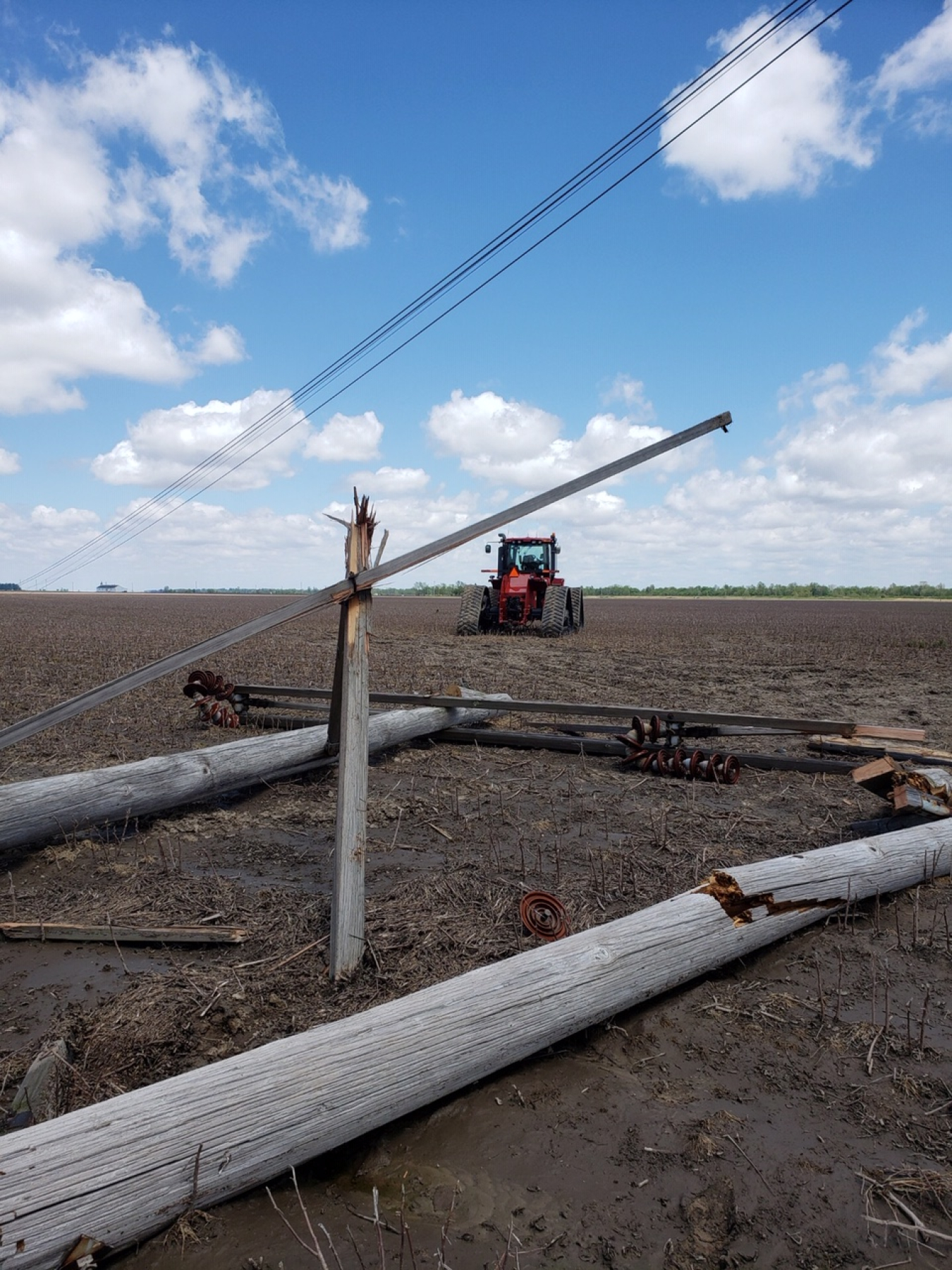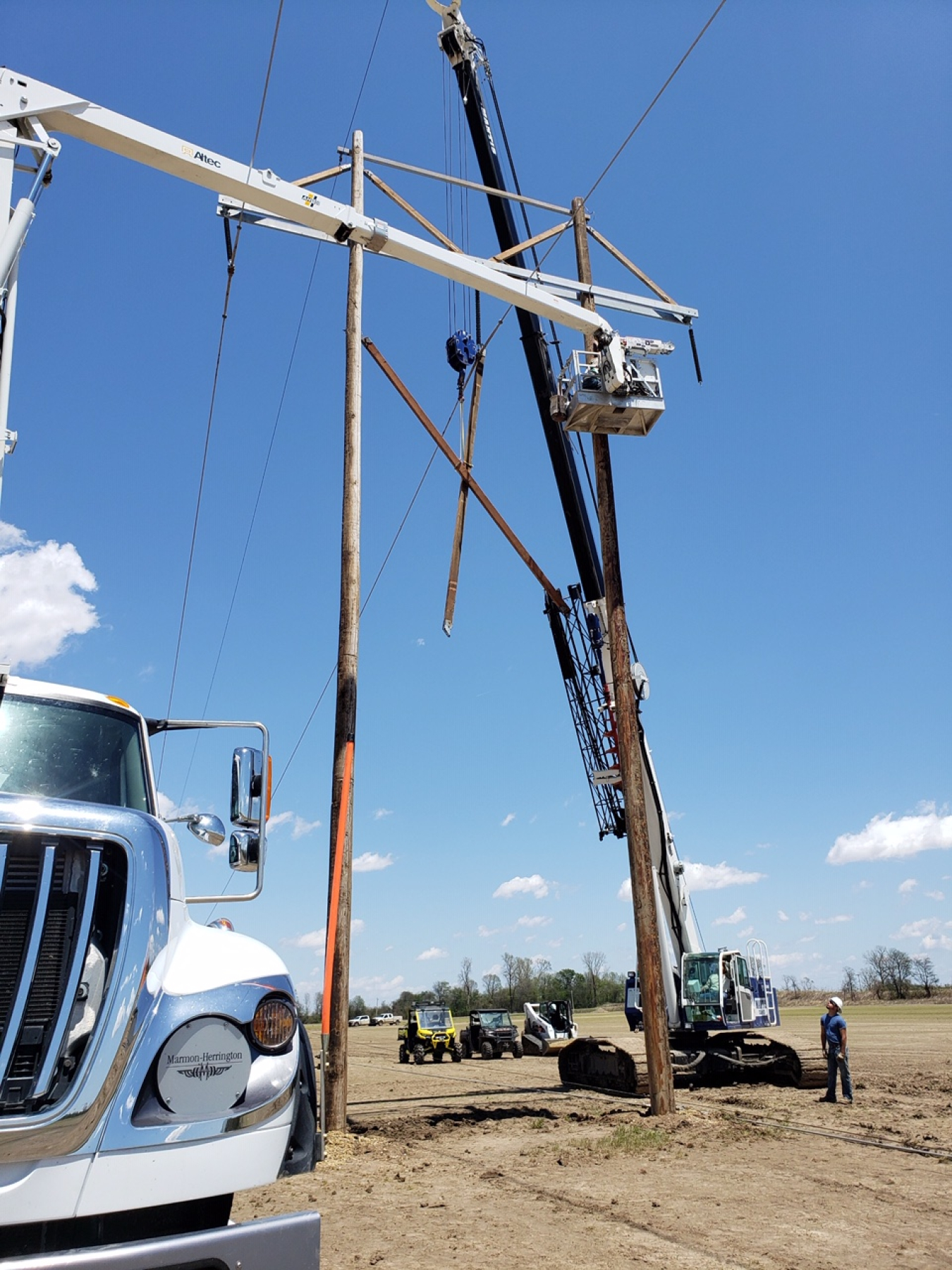Southwestern Crews Respond to Major Storm Damage in Missouri
Southwestern Power Administration
May 12, 2020Southwestern Crews Respond to Major Storm Damage in Missouri
Last Updated: October 29, 2020
A series of severe storms with straight-line winds and macrobursts that occurred on Sunday, May 3, 2020, and again the following day, saw nearly 70 transmission structures on Southwestern’s 161-kilovolt (kV) Kennett to New Madrid line in southeast Missouri damaged or completely destroyed in a path totaling nearly 10 miles.
The transmission line tripped out of service mid-afternoon Sunday, and Southwestern’s Jonesboro, Arkansas, Transmission Line Crew reported one structure down and another with damage. The line was still out of service Monday, May 4, 2020, when another series of storms rolled through, leaving even more devastation in their wake.
Jonesboro Regional Maintenance Manager Chad Holmes says that initially Southwestern did not realize the extent of the damage from Monday’s storm since the line was already out of service, but when his Transmission Line Foreman Ross Murray began receiving phone calls from landowners and neighboring utilities, Holmes and his crews soon realized something was amiss.
“We had a call from Ameren saying that they had about 5,000 customers out of service due to an outage on one of its 14-kV lines that crosses under our Kennett to New Madrid line,” he explains. “When the Jonesboro Transmission Line Crew went out to investigate Monday, they found not only that downed crossing, but another 65 plus structures and miles of twisted conductor lying on the ground with various roads blocked.”

Holmes says the immediate priority was identifying the downed structures and conductor that cross public thoroughfares or intersect with other utilities, such as those at the Ameren crossing. Jonesboro crews worked through the night on Monday to identify such sites, tracing the path of the storm and assessing the damage.
By Tuesday, May 5th, it became apparent that a significant expenditure would be needed for repairs at these sites and for the rest of the line lying in the fields and farmland of what is referred to as the Missouri bootheel. Holmes estimated a price tag of over $500,000 for materials, labor, and equipment, and requested Southwestern administrative, finance and procurement staff begin the process of ordering the needed supplies.
Meanwhile, the Jonesboro crews continued to haul equipment and materials already on hand to the area affected, working with landowners to establish staging locations and wrecking out damaged structures. By Wednesday, May 6th, Jonesboro crews were able to build a guard structure at the Ameren crossing, allowing Ameren to re-energize its 14-kV line.
Holmes says all three Southwestern Field Offices, as well as Tulsa Headquarters, have been involved with the restoration effort, working on the logistics of ordering materials, supplies, and services, including blanket purchase orders of poles, cross-arms, and miscellaneous materials and supplies such as pole hardware, gravel, and haul-off services for debris removal.
Additionally, he says that since most of the damaged structures are located in freshly planted rice and bean fields, the agency also had to rent equipment that can help Southwestern’s trucks get through water and mud.
Southwestern’s Springfield and Gore Transmission Line and Right of Way crews quickly mobilized to help with the massive restoration effort. Springfield crews arrived Wednesday and began staging equipment at the south end of the damaged section, while Gore crews arrived Thursday and began work at the north end. Jonesboro crews continued their work on the line crossings with other utilities and wrecking out structures as needed.
Holmes reported that the National Weather Service (NWS) determined the damage that affected Southwestern’s Kennett to New Madrid line and other structures in the area was from one or more macrobursts, which the NWS defines as “convective downdrafts with an affected outflow area of at least 2½ miles wide and peak winds lasting between 5 and 20 minutes.” The NWS compares some macrobursts to tornadoes with an F3 intensity.

The repair to the damaged Kennett to New Madrid line is expected to take around a month to complete. “We may be done around Memorial Day if we get cooperation from the weather,” predicts Chad Holmes. Holmes says cooperation from landowners in the area has already been extremely helpful in getting efforts underway. “The landowners have been very cooperative in working with our crews, and we really appreciate that,” he says.
Prior to the onset of the severe weather, Southwestern crews were on a “home to work” status due to the outbreak of the Coronavirus. They had been encouraged to wear Personal Protective Equipment (PPE) and maintain social distancing while doing their jobs keeping Southwestern’s transmission system in order, but they had also been allowed to return to their respective homes after work, instead of staying at hotels, to prevent unneeded contact with others.
To be able to effectively repair the damage caused by the storms in a timely manner, however, Holmes says crews are staying a nearby hotel until the damage can be repaired. “The hotel has disinfected the premises and agreed to limit cleaning services to changing out towels and linens as needed,” he says. “The crews are still being encouraged to wear PPE and maintain social distancing as much as possible.”

